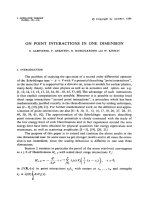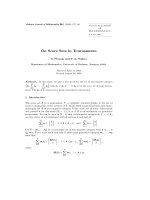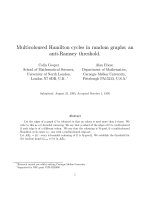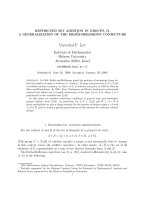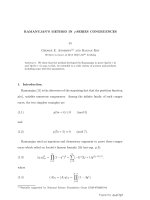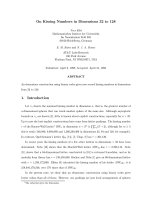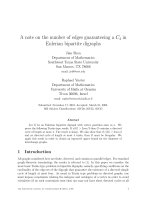Báo cáo toán học: "Nowhere-zero 3-flows in squares of graphs" pdf
Bạn đang xem bản rút gọn của tài liệu. Xem và tải ngay bản đầy đủ của tài liệu tại đây (115.97 KB, 8 trang )
Nowhere-zero 3-flows in squares of graphs
Rui Xu and Cun-Quan Zhang
∗
Department of Mathematics
West Virginia University, West Virginia, USA
,
Submitted: May 31, 2002; Accepted: Jan 15, 2003; Published: Jan 22, 2003
MR Subject Classifications: 05C15, 05C20, 05C70, 05C75, 90B10
Abstract
It was conjectured by Tutte that every 4-edge-connected graph admits a nowhere-
zero 3-flow. In this paper, we give a complete characterization of graphs whose
squares admit nowhere-zero 3-flows and thus confirm Tutte’s 3-flow conjecture for
the family of squares of graphs.
1 Introduction
All graphs considered in this paper are simple. Let G =(V,E) be a graph with vertex set
V and edge set E. For any v ∈ V (G), we use d
G
(v),N
G
(v) to denote the degree and the
neighbor set of v in G, respectively. The minimal degree of a vertex of G is denoted by
δ(G). We use K
m
for a complete graph on m vertices, P
t
for a path of length t and W
4
for a graph obtained from a 4-circuit by adding a new vertex x and edges joining x to all
the vertices on the circuit. We call x the center of this W
4
and each edge with x as one
end is called a center edge. Let D be an orientation of G. Then the set of all edges with
tails (or heads) at a vertex v is denoted by E
+
(v)(orE
−
(v)). If an edge uv is oriented
from u to v under D,thenwesayD(uv)=u → v. The square of G, denoted by G
2
,is
the graph obtained from G by adding all the edges that join distance 2 vertices in G.We
refer the reader to [1] for terminology not defined in this paper.
Definition 1.1 Let D be an orientation of G and f be a function: E(G) → Z. Then
(1). The ordered pair (D, f) is called a k-flow of G if −k +1 ≤ f(e) ≤ k −1 for every
edge e ∈ E(G) and
e∈E
+
(v)
f(e)=
e∈E
−
(v)
f(e) for every v ∈ V (G).
(2). The ordered pair (D, f) is called a Modular k-flow of G if for every v ∈ V (G),
e∈E
+
(v)
f(e) ≡
e∈E
−
(v)
f(e) (modk).
∗
Partially supported by the National Security Agency under Grant MDA904-01-1-0022.
the electronic journal of combinatorics 10 (2003), #R5 1
The support of a k-flow (Modular k-flow) (D, f) of G is the set of edges of G with
f(e) =0(f(e) ≡ 0 (mod k)), and is denoted by supp(f ).Ak-flow (D, f) (Modular
k-flow) of G is nowhere-zero if supp(f)=E(G).
For convenience, a nowhere-zero k-flow is abbreviated as a k-NZF. The concept of
integer-flow was introduced by Tutte([7, 8] also see [9, 4]) as a refinement and generaliza-
tion of the face-coloring and edge-3-coloring problems. One of the most well known open
problems in this subject is the following conjecture due to Tutte:
Conjecture 1.2 (Tutte, unsolved problem 48 in [1]) Every 4-edge-connected graph admits
a 3-NZF.
Squares of graphs admitting 3-NZF’s are to be characterized in this paper. The fol-
lowing families of graphs are the exceptions in the main theorem.
Definition 1.3 T
1,3
= {T | T isatreeandd
T
(v)=1or 3 for every v ∈ V (T )}
Definition 1.4
¯
T
1,3
= {T | T ∈T
1,3
or T is a 4-circuit or T can be obtained from some
T
∈T
1,3
by adding some edges each of which joins a pair of distance 2 leaves of T
}
The following is the main result of this paper.
Theorem 1.5 Let G be a connected simple graph. Then G
2
admits a 3-NZF if and only
if G/∈
¯
T
1,3
.
An immediate corollary of Theorem 1.5 is the following partial result to Tutte’s 3-flow
conjecture (Conjecture 1.2).
Corollary 1.6 Let G be a graph. If δ(G
2
) ≥ 4 then G
2
admits a 3-NZF.
This research is motivated by Conjecture 1.2 and the following open problem:
Conjecture 1.7 (Zhang [11]) If every edge of a 4-edge-connected graph G is contained
in a circuit of length at most 3 or 4, then G admits a 3-NZF.
Theorem 1.5 and the following early results are partial results of the open problem
above.
Theorem 1.8 (Catlin [2]) If every edge of a graph G is contained in a circuit of length
at most 4, then G admits a 4-NZF.
Theorem 1.9 (Lai [5]) Every 2-edge-connected, locally 3-edge-connected graph admits a
3-NZF.
Theorem 1.10 (Imrich and Skrekovski [3]) Let G and H be two graphs. Then G × H
admits a 3-NZF if both G and H are bipartite.
the electronic journal of combinatorics 10 (2003), #R5 2
2 Splitting operation, flow extension and lemmas
Definition 2.1 (A special splitting operation) Let G be a graph and e = xy ∈ E(G).The
graph G
∗e
is obtained from G by deleting the edge e and adding two new vertices x
and
y
and adding two new edges, e
x
and e
y
, joining x and y
, y and x
, respectively.
Definition 2.2 Let G be a graph, let (D, f) be a 3-flow of G and let F ⊆ E(G)\supp(f).
A3-flow(D
,f
) of G is called an (F, f)-changer if F ∪ supp(f) ⊆ supp(f
).
Lemma 2.3 ([7]) A graph G admits a k-flow (D, f
1
) if and only if G admits a Modular
k-flow (D, f
2
) such that f
1
(e) ≡ f
2
(e)(modk) for each e ∈ E(G).
An orientation of a graph G is called a modular 3-orientation if |E
+
(v)|≡|E
−
(v)| (mod 3),
for every v ∈ V (G). The following result appears in [4, 6, 9], but by Lemma 2.3, we can
attribute it to Tutte.
Lemma 2.4 ([7]) Let G be a graph. Then G admits a 3-NZF if and only if G has a
modular 3-orientation.
A partial 3-orientation D of G is an orientation of some edges of G satisfying
|E
+
(v)|≡|E
−
(v)| (mod 3), for any v ∈ V (G). The support of D is the set of edges
oriented under D and is denoted by supp(D). Clearly the partial orientation obtained by
reversing every oriented edge of a partial 3-orientation is also a partial 3-orientation.
Let D be a partial 3-orientation of G and let C = v
0
v
1
···v
k−1
v
0
be a circuit of G.A
circuit-operation along C is defined as following: For 0 ≤ i ≤ k −1, if D(v
i
v
i+1
)=v
i
→
v
i+1
(mod k), then reverse the direction of this edge; if (v
i
v
i+1
)(modk) is not oriented
under D,thenorientitasv
i
→ v
i+1
;ifD(v
i
v
i+1
)=v
i+1
→ v
i
(mod k)thenv
i
v
i+1
loses
it’s orientation.
Lemma 2.5 Let G be a graph, (D, f) be a 3-flow of G and H be a subgraph of G
(1). If H
∼
=
W
4
and e ∈ E(H) \ supp(f) is a center edge, then an ({ e},f)-changer
exists.
(2). If H is a circuit of length 3 with E(H) ∩ supp(f)={e}, then an (E(H) \{e},f)-
changer exists.
Proof. (1). Since H
∼
=
W
4
,letx be the center of H and let u
1
u
2
u
3
u
4
u
1
be the 4-
circuit H \ x.SinceG has a 3-flow (D, f), then G has a partial 3-orientation D
∗
with
supp(D
∗
)=supp(f). We need only to find a partial 3-orientation D
such that supp(D
∗
)∪
{e}⊆supp(D
). Since e is a center edge, without loss of generality, assume that e = xu
1
.
First we assume E(H)\{e}⊆supp(D
∗
). Without loss of generality, assume D
∗
(u
1
u
2
)=
u
1
→ u
2
.ThenD
∗
(u
2
x)=x → u
2
. Otherwise, we do a circuit-operation along u
1
u
2
xu
1
and then get a needed partial 3-orientation D
of G. For the same reason, u
4
must be the
tail (or head) of both u
1
u
4
and xu
4
. By symmetry, we consider the following two cases.
Case 1. D
∗
(u
1
u
4
)=u
1
→ u
4
and D
∗
(xu
4
)=x → u
4
.
the electronic journal of combinatorics 10 (2003), #R5 3
We may assume that u
3
is the tail (or head) of all edges incident with it in H. Oth-
erwise, there exists a directed 2-path xu
3
u
i
(or u
i
u
3
x) for some i ∈{2, 4}.Thenwe
do circuit-operations along xu
3
u
i
x (or u
i
u
3
xu
i
) and along u
1
u
i
xu
1
. Therefore, we get a
needed partial 3-orientation of D
of G.
If all edges in H have u
3
as a tail, then we do circuit-operations along xu
1
u
4
x,along
u
4
xu
3
u
4
,alongxu
3
u
2
x and along u
2
xu
1
u
2
;IfalledgesinH have u
3
as a head, then we
do circuit-operations along u
1
u
2
u
3
xu
1
and along u
3
xu
4
u
3
. In both cases, we get a needed
partial 3-orientation D
of G.
Case 2. D
∗
(u
1
u
4
)=u
4
→ u
1
and D
∗
(xu
4
)=u
4
→ x.
SimilartoCase1,wemayassumeu
3
be the tail (or head) of all edges incident with
it in H.IfalledgesinH have u
3
as a tail, then we do circuit-operations along xu
1
u
4
x,
along u
3
u
4
u
1
u
2
u
3
and along u
3
xu
2
u
3
;IfalledgesinH have u
3
as a head, then we do
circuit-operations along u
1
xu
2
u
1
,alongu
4
u
1
u
2
u
3
u
4
and along u
4
xu
3
u
4
. In both cases, we
get a needed partial 3-orientation D
of G.
If supp(D
∗
) misses some other edges of E(H), say e
∗
= ab ∈ E(H) \ supp(D
∗
), then
we define D
∗
(ab)=a → borb→ a, by the proof of Case 1 and Case 2, we can find a
needed D
of G.
(2). it is trivial.
Lemma 2.6 For each G ∈
¯
T
1,3
and each e
0
∈ E(G), the graph G
2
admits a 3-flow (D, f)
such that supp(f)=E(G
2
) \{e
0
}
Proof. Induction on |E(G)|. It is obviously true for graphs G with G
2
= K
4
(including
G = C
4
, the circuit of length 4). So, assume that |V (G)|≥5andletD be any fixed
orientation of G
2
.
Let e = xy with d
G
(x)=d
G
(y)=3. ThenG
∗e
consists of two components, say G
1
and G
2
. Clearly, G
1
,G
2
∈
¯
T
1,3
. Without loss of generality, let e
0
∈ E(G
1
). By induction,
G
2
1
admits a 3-flow (D, f
1
) such that supp(f
1
)=E(G
2
1
) \{e
0
} and G
2
2
admits a 3-flow
(D, f
2
)thatsupp(f
2
)=E(G
2
2
) \{e}.
Then, identifying the split vertices and edges, back to G,(D, f
1
+f
2
)isa3-flow(D, f)
with supp(f )=E(G
2
) \{e
0
}.
Lemma 2.7 (1). Let G be a k-path with k ≥ 2 or an m-circuit with m =3or m ≥ 5.
Then G
2
admits a 3-NZF.
(2). Let G be a graph obtained from an r-circuit x
0
x
1
···x
r−1
x
0
by attaching an edge
x
i
v
i
at each x
i
for 0 ≤ i ≤ r − 1, where v
i
= v
j
if i = j. Then G
2
admits a 3-NZF.
(3). Let G be a graph obtained from an m-circuit x
0
x
1
···x
m−1
x
0
by attaching an edge
x
m−1
v at x
m−1
alone, where m ≥ 5. Then G
2
admits a 3-NZF.
Proof. (1). If G is an m-circuit with m =3orm ≥ 5, then G
2
is a cycle (every vertex
is of even degree) and G
2
admits 2-NZF. If G is a k-path with k ≥ 2, by induction on k
and using Lemma 2.5-(2), G
2
admits a 3-NZF.
(2). For r ≥ 5(orr =3): letD be an orientation such that v
i
(0 ≤ i ≤ r − 1)
is the tail of every edge of G
2
incident with it and all the other edges are oriented as
the electronic journal of combinatorics 10 (2003), #R5 4
x
i
→ x
i+1
,x
i
→ x
i+2
(mod r)(orx
i
→ x
i+1
(mod 3) only for r = 3). Obviously, D is a
modular 3-orientation of G
2
.
For r =4: letD be the orientation such that v
0
and v
2
be the tail of every edge of G
2
incident with it, v
1
and v
3
be the head of every edge of G
2
incident with it, x
0
x
1
x
3
x
2
x
0
as a directed circuit and other edges are oriented as x
3
→ x
0
, x
1
→ x
2
. Obviously, D is a
modular 3-orientation of G
2
.
(3). Orient all the edges as x
i
→ x
i+1
,x
i
→ x
i+2
(mod m) for 0 ≤ i ≤ m − 1and
let v be the tail of every edge of G
2
incident with it. Then reverse the direction of the
following edges: x
0
x
m−1
,x
0
x
m−2
. Clearly, this orientation is a modular 3-orientation of
G
2
.
3 Proof of the main theorem
Proof. =⇒ By contradiction. Suppose G ∈
¯
T
1,3
.LetG be a counterexample with
|V (G)| + |E(G)| as small as possible. Clearly |V (G)|≥5andG contains no circuits. So
G ∈T
1,3
.Letv ∈ V (G) be a degree 3 vertex such that N
G
(v)={v
1
,v
2
,v
3
},d
G
(v
1
)=
d
G
(v
2
)=1. Clearly,G
1
= G \{v
1
,v
2
}∈T
1,3
.SinceG
2
has a modular 3-orientation D
and both v
1
and v
2
are degree 3 vertices in G
2
, then this orientation restricted to the edge
set of G
2
1
will generate a modular 3-orientation of G
2
1
. Therefore, G
2
1
admits a 3-NZF, a
contradiction.
⇐=LetG be a counterexample to the theorem such that
(i). |E(G)|−|V (G)| is as small as possible,
(ii). subject to (i), |E(G)| is as small as possible.
Note that |E(G)|−|V (G)| + 1 is the rank of the cycle space of G.
Claim 1. Let e
0
= xy ∈ E(G).Ifd
G
(x) ≥ 3 and d
G
(y) ≥ 2, then xy is not a cut edge
of G.
If e
0
is a cut-edge, then at least one component of G
∗e
0
is not in
¯
T
1,3
,say,G
1
is not,
while G
2
might be. By induction, let (D, f
i
)bea3-flowofG
2
i
for each i =1, 2 such that
f
1
is nowhere-zero, f
2
mightmissonlyoneedgee
x
(that is a copy of e
0
). Without loss of
generality, assume that f
1
(e
y
)+f
2
(e
x
) ≡ 0 (mod (3)). Then, identifying the split vertices
and edges, back to G,(D, f
1
+f
2
) is a nowhere-zero Modular 3-flow of G
2
. By Lemma 2.3,
G
2
admits a 3-NZF, a contradiction.
Claim 2. d
G
(x) ≤ 3 for any x ∈ V (G).
Otherwise, assume that d
G
(x) ≥ 4 for some vertex x ∈ V (G). Clearly G
∼
=
K
1,m
for m ≥ 4sinceK
1,m
is not a counterexample. So there exists e
0
= xy ∈ E(G)with
d
G
(y) ≥ 2. By Claim 1, e
0
isnotacutedgeofG and G
1
= G
∗e
0
/∈
¯
T
1,3
.Thenby(i),G
2
1
admits a 3-NZF.
In G
2
1
,identifyx and x
, y and y
, and use one edge to replace two parallel edges, by
Lemma 2.3, we will get G
2
and a Modular 3-flow (D, f)ofG
2
such that E(G
2
)\supp(f ) ⊆
{xv or yw | v ∈ N
G
(y),w∈ N
G
(x)}.LetC(x)=G
2
[N
G
(x) ∪{x}]. Then C(x) is a clique
of order at least 5. We are to adjust (D, f) so that the resulting Modular 3-flow (D, f
)
the electronic journal of combinatorics 10 (2003), #R5 5
of G
2
misses only edges of {uv | u, v ∈ V (C(x))}. For each edge xv which is missed by
supp(f)andxv ∈ E(C(x)), xyvx must be a circuit of G
2
,solet(D, f
xv
)bea3-flowof
G
2
with supp(f
xv
)={xy, yv, xv} and f
xv
(yv)+f(yv) ≡ 0(mod3). Now(D, f + f
xv
)
is a Modular 3-flow of G
2
whose support contains xv, yv, but may miss xy. Repeat this
adjustment and do the similar adjustment for the edges yw not in the support until we
get a Modular 3-flow (D, f
)ofG
2
such that E(G
2
) \ supp(f
) ⊆ E(C(x)). Since each
edge in C(x) is contained in some K
5
andthusisacenteredgeinsomeW
4
, by Lemma 2.3
and Lemma 2.5-(1), G
2
admits a 3-NZF, a contradiction.
Claim 3. No degree 2 vertex is contained in a 3-circuit.
By contradiction. Assume xyzx is a circuit of G with d
G
(x)=2. Ifd
G
(y)=2,then
we must have d
G
(z) = 3. Therefore G
1
= G \{xy} /∈
¯
T
1,3
and G
2
1
= G
2
, contradicting
(ii). So d
G
(y)=d
G
(z)=3.
Let N
G
(y)={x, y
,z} and N
G
(z)={x, y, z
}.LetG
1
= G −{x}.Since(N
G
(y) ∩
N
G
(z)) \{x} = ∅ (otherwise, let G
2
= G \{yz},thenG
2
2
= G
2
, G
2
/∈
¯
T
1,3
, contradicting
(ii)) and d
G
1
(y)=2,thenG
1
∈
¯
T
1,3
.SoG
2
1
admits a 3-NZF. Since E(G
2
) \ E(G
2
1
)=
{xy, xy
,xz,xz
}, by Lemma 2.5-(2), G
2
admits a 3-NZF, a contradiction.
Claim 4. No degree 2 vertex of G is contained in a 4-circuit.
Assume C = xu
1
u
2
u
3
x is a 4-circuit of G and d
G
(x) = 2. By Claim 3, u
1
u
3
/∈ E(G).
Let u
i
be the adjacent vertex of u
i
which is not in V (C)ifd
G
(u
i
) = 3 for some i ∈{1, 2, 3}.
Let G
1
= G \{x}. We consider the following 3 cases.
Case 1. d
G
(u
1
)=d
G
(u
3
)=2.
Then d
G
(u
2
)=3andd
G
(u
2
) ≥ 2(ifd
G
(u
2
) = 1, it’s easy to show G
2
admits a 3-NZF).
Clearly, u
2
u
2
is a cut edge, contradicting Claim 1.
Case 2.Exactlyoneofu
1
,u
3
has degree 3.
Assume d
G
(u
1
)=3andd
G
(u
3
)=2. Sinced
G
1
(u
1
)=2,ifd
G
1
(u
1
)=2thenu
1
is not
contained in a 3-circuit in G (by Claim 3), and so G
1
/∈
¯
T
1,3
. By induction, G
2
1
admits a
3-NZF. Since E(G
2
) \ E(G
2
1
)={xu
1
,xu
1
,xu
2
,xu
3
} and G
2
[V (C) ∪{u
1
}]containsaW
4
with x as its center, by Lemma 2.5-(1), G
2
admits a 3-NZF, a contradiction.
Case 3. d
G
(u
1
)=d
G
(u
3
)=3.
If u
1
= u
3
,thenu
1
u
1
u
2
u
3
is a 3-path, otherwise u
1
u
1
u
2
u
3
u
3
is 4-path. In both cases
G
2
1
admits a 3-NZF. Since E(G
2
) \ E(G
2
1
)={xu
1
,xu
1
,xu
2
,xu
3
,xu
3
} and each edge xu
i
or xu
j
iscontainedinsomeW
4
in G
2
as a center edge for 1 ≤ i ≤ 3andj =1, 3, by
Lemma 2.5-(1), G
2
admits a 3-NZF. a contradiction.
Claim 5. For any v ∈ V (G), d
G
(v) =2.
Otherwise, if there exists v ∈ V (G) such that d
G
(v) = 2, then by Claim 3-4, v is not
contained in any circuits of length 3 or 4. By Lemma 2.7-(1), G cannot be a k-path with
k ≥ 2oranm-circuit with m =3orm ≥ 5. Let us consider the following cases.
Case 1. There exists a path P
m
= v
1
v
2
···v
m
such that m ≥ 3,v= v
t
for some
2 ≤ t ≤ m − 1, d
G
(v
k
) = 2 for 2 ≤ k ≤ m − 1andd
G
(v
1
) =2,d
G
(v
m
) =2.
Clearly, at least one of v
1
,v
m
has degree 3. If d
G
(v
i
)=3fori =1,orm,let
N
G
(v
i
) \ V (P
m
)={v
i
,v
i
}. Clearly, G
1
= G \{v
2
,v
3
, ,v
m−1
} /∈
¯
T
1,3
(because by
the electronic journal of combinatorics 10 (2003), #R5 6
Claim 3, degree 2 vertices are not contained in any 3-circuits of G). By Claim 1, G
1
is connected. So G
2
1
admits a 3-NZF (D, f
1
). By Lemma 2.7-(1), P
2
m
admits a 3-NZF
(D, f
2
). Then G
2
admits a 3-flow (D, f)withsupp(f )=supp(f
1
) ∪ supp(f
2
). By Claim
3-4, E(G
2
) \ supp(f)={v
2
v
1
,v
2
v
1
,v
m−1
v
m
,v
m−1
v
m
}, then by Lemma 2.5-(2), G
2
admits
a 3-NZF, a contradiction.
Case 2. There exists a m-circuit C = v
1
v
2
···v
m
v
1
with m ≥ 5, d
G
(v
i
)=2for
1 ≤ i ≤ m − 1, d
G
(v
m
)=3andv = v
t
for some 1 ≤ t ≤ m − 1.
Suppose that v
0
∈ N
G
(v
m
) \ V (C). By Claim 1, d
G
(v
0
) = 1. So by Lemma 2.7-(3), G
2
admits a 3-NZF, a contradiction.
Claim 6. Let e = xy ∈ E(G) with d
G
(x)=d
G
(y)=3. Then e is contained in a circuit
of length 3 or 4.
By contradiction. Let G
1
be the graph obtained from G by deleting the edge e and
adding a new vertex y
and a new edge xy
.SinceG contains no degree 2 vertices and
d
G
1
(y)=2,thenG
1
/∈
¯
T
1,3
. By Claim 1, e isnotacutedgeofG,thenby(i),G
2
1
admits a
3-NZF (D, f
1
). Identify y and y
, the resulting 3-flow (D, f
2
)inG
2
misses only two edges
y
1
x and y
2
x where N(y)={y
1
,y
2
,x} (since xy is not contained a circuit of length 3 or
4). By Lemma 2.5-(2), G
2
admits a 3-NZF, a contradiction.
Claim 7. For each x ∈ V (G) with d
G
(x)=3, | N
G
(x) ∩ V
3
|≤2, where V
3
is the set of
all the degree 3 vertices of G.
By contradiction. Assume that U = {u
1
,u
2
,u
3
} = N
G
(x) ∩ V
3
.LetG
1
= G \{x}.By
Claim 1, G
1
is connected. Since G contains no degree 2 vertices, G
1
/∈
¯
T
1,3
and G
2
1
admits
a3-NZF(D, f). By Claim 6, each xu
i
(1 ≤ i ≤ 3) is contained a circuit of length at most
4. We consider the following 3 cases.
Case 1. G[U] contains at least 2 edges.
Suppose that u
1
u
2
,u
2
u
3
∈ E(G). Let u
i
∈ N
G
(u
i
) \ U for i =1, 3. If u
1
= u
3
,then
G
2
[U ∪{u
1
,x}]
∼
=
K
5
, by Lemma 2.5-(1), we can get a 3-NZF of G
2
, a contradiction. If
u
1
= u
3
,thenG[u
1
u
1
u
2
u
3
u
3
] is a 4-path, by Lemma 2.5-(1) (similar to Case 3 of Claim
4), we can get a 3-NZF of G
2
, a contradiction.
Case 2. G[U] contains exactly 1 edge.
Assume that u
1
u
2
∈ E(G). By Claim 6, each edge xu
i
(i =1, 2, 3) is contained in
a circuit of length 3 or 4. So we may assume z ∈ (N
G
(u
2
) ∩ N
G
(u
3
)) \{x}. Clearly,
G
∗
= G
2
[U ∪{x, z}]
∼
=
K
5
.Letu
i
∈ N
G
(u
i
) \ (U ∪{z}) for i =1, 3. Clearly, E(G
2
) \
supp(f) ⊆ E(G
∗
) ∪{xu
1
,xu
3
}.Sincexu
j
u
j
x(j =1, 3) is a circuit of G
2
, we can get a
3-flow (D, f
1
) such that E(G
2
) \ supp(f
1
) ⊆ E(G
∗
). By Lemma 2.5-(1), we can get a
3-NZF of G
2
, a contradiction.
Case 3. G[U]containsnoedges.
Assume that z
1
∈ (N
G
(u
1
) ∩ N
G
(u
2
)) \{x} and z
2
∈ (N
G
(u
1
) ∩ N
G
(u
3
)) \{x}.Let
G
2
= G \{xu
1
},thenG
2
/∈
¯
T
1,3
and G
2
2
admits a 3-NZF (D, f
1
). Clearly, E(G
2
) \
supp(f
1
)={xu
1
}.Sincexu
1
iscontainedinaW
4
which is contained in the graph induced
by {u
1
,z
1
,u
2
,u
3
,x} in G
2
with x as center, by Lemma 2.5-(1), we can get a 3-NZF of G
2
,
a contradiction.
the electronic journal of combinatorics 10 (2003), #R5 7
Final Step. By Claim 2, Claim 5 and Claim 7, all vertices of G have degree 1 or 3 and
each degree 3 vertex is adjacent to at most 2 degree 3 vertices. So G[V
3
]isapathora
circuit, hence G must be a graph obtained from an r-circuit x
0
x
1
···x
r−1
x
0
by attaching
an edge x
i
v
i
at each x
i
for 0 ≤ i ≤ r − 1, where v
i
= v
j
if i = j,orapathx
0
x
1
···x
p
by attaching an edge v
i
x
i
(1 ≤ i ≤ p − 1) at each x
i
,wherev
i
= v
j
if i = j. Clearly the
latter case is a graph in
¯
T
1,3
. By Lemma 2.7-(2), G
2
admits a 3-NZF, a contradiction.
References
[1]J.A.BondyandU.S.R.Murty,Graph Theory with Applications. Macmillan,
London, (1976).
[2] P. A. Catlin, Double cycle covers and the Petersen graph, J. Graph Theory,13
(1989) 465-483.
[3] W. Imrich and R. Skrekovski, A theorem on integer flows on Cartesian product of
graphs, J. Graph Theory, (to appear).
[4] F. Jaeger, Nowhere-zero flow problems, in: L. Beineke and R. Wilson, eds., Selected
Topics in Graph Theory 3 (Wiley, New York, 1988)71-95.
[5] H J. Lai. Nowhere-zero 3-flows in locally connected graphs, J. Graph Theory, (to
appear).
[6] R. Steinberg and D. H. Younger, Gr¨otzsch’s theorem for the projective plane, Ars
Combin., 28, (1989)15-31.
[7] W. T. Tutte, On the embedding of linear graphs in surfaces, Proc. London Math.
Soc., Ser. 2, 51 (1949)474-483.
[8] W. T. Tutte, A contribution on the theory of chromatic polynomial, Canad. J.
Math., 6 (1954)80-91.
[9] D.H.Younger,Intergerflows,J. Graph Theory, 7 (1983)349-357.
[10] C. Q. Zhang, Integer Flows and Cycle Covers of Graphs, Marcel Dekker, New York
(1997).
[11] C. Q. Zhang, Integer Flows and Cycle Covers, Plenary lecture at Graph Theory
Workshop, Nanjing Normal University, April, 1998.
the electronic journal of combinatorics 10 (2003), #R5 8
